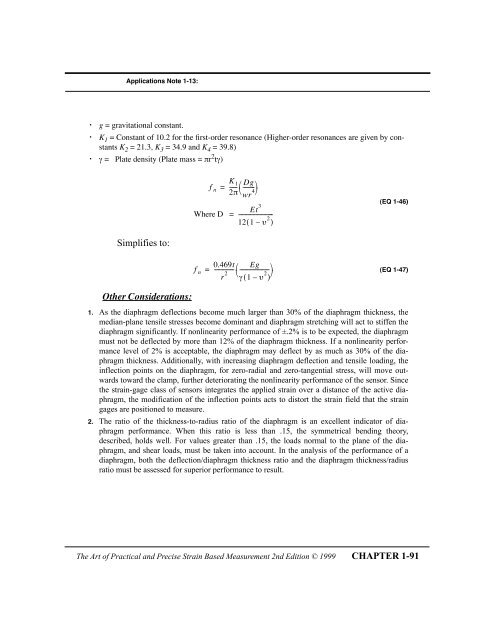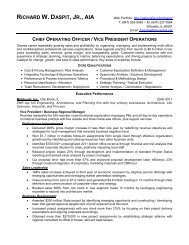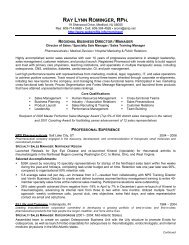The Art of Practical and Precise Strain Based ... - Webprofile.info
The Art of Practical and Precise Strain Based ... - Webprofile.info
The Art of Practical and Precise Strain Based ... - Webprofile.info
- No tags were found...
Create successful ePaper yourself
Turn your PDF publications into a flip-book with our unique Google optimized e-Paper software.
Applications Note 1-13:¥ g = gravitational constant.¥ K 1 = Constant <strong>of</strong> 10.2 for the Þrst-order resonance (Higher-order resonances are given by constantsK 2 = 21.3, K 3 = 34.9 <strong>and</strong> K 4 = 39.8)¥ g = Plate density (Plate mass = pr 2 tg)K 1 Dgf n = ----- æ--------ö2pèwr 4 øWhere D =Et 3-------------------------12( 1 Ð u 2 )(EQ 1-46)Simplifies to:0.469t Egf n = -------------- æ----------------------ör 2 èg ( 1 Ð u 2 )ø(EQ 1-47)Other Considerations:1. As the diaphragm deflections become much larger than 30% <strong>of</strong> the diaphragm thickness, themedian-plane tensile stresses become dominant <strong>and</strong> diaphragm stretching will act to stiffen thediaphragm significantly. If nonlinearity performance <strong>of</strong> ±.2% is to be expected, the diaphragmmust not be deflected by more than 12% <strong>of</strong> the diaphragm thickness. If a nonlinearity performancelevel <strong>of</strong> 2% is acceptable, the diaphragm may deflect by as much as 30% <strong>of</strong> the diaphragmthickness. Additionally, with increasing diaphragm deflection <strong>and</strong> tensile loading, theinflection points on the diaphragm, for zero-radial <strong>and</strong> zero-tangential stress, will move outwardstoward the clamp, further deteriorating the nonlinearity performance <strong>of</strong> the sensor. Sincethe strain-gage class <strong>of</strong> sensors integrates the applied strain over a distance <strong>of</strong> the active diaphragm,the modification <strong>of</strong> the inflection points acts to distort the strain field that the straingages are positioned to measure.2. <strong>The</strong> ratio <strong>of</strong> the thickness-to-radius ratio <strong>of</strong> the diaphragm is an excellent indicator <strong>of</strong> diaphragmperformance. When this ratio is less than .15, the symmetrical bending theory,described, holds well. For values greater than .15, the loads normal to the plane <strong>of</strong> the diaphragm,<strong>and</strong> shear loads, must be taken into account. In the analysis <strong>of</strong> the performance <strong>of</strong> adiaphragm, both the deflection/diaphragm thickness ratio <strong>and</strong> the diaphragm thickness/radiusratio must be assessed for superior performance to result.<strong>The</strong> <strong>Art</strong> <strong>of</strong> <strong>Practical</strong> <strong>and</strong> <strong>Precise</strong> <strong>Strain</strong> <strong>Based</strong> Measurement 2nd Edition © 1999 CHAPTER 1-91
















